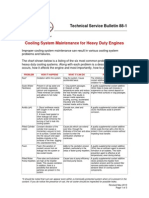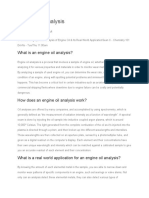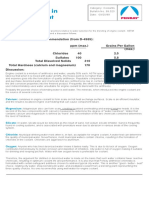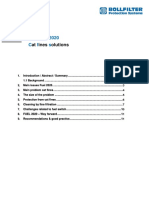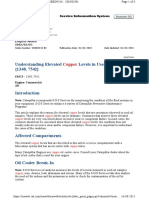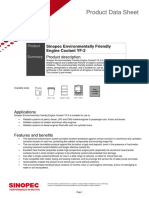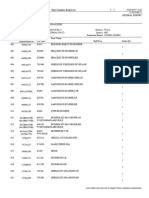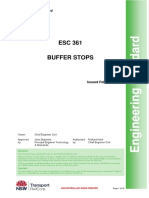Mitsubishi Diesel Engine Technical Information: Coolant Additives
Mitsubishi Diesel Engine Technical Information: Coolant Additives
Uploaded by
Moniru islamCopyright:
Available Formats
Mitsubishi Diesel Engine Technical Information: Coolant Additives
Mitsubishi Diesel Engine Technical Information: Coolant Additives
Uploaded by
Moniru islamOriginal Description:
Original Title
Copyright
Available Formats
Share this document
Did you find this document useful?
Is this content inappropriate?
Copyright:
Available Formats
Mitsubishi Diesel Engine Technical Information: Coolant Additives
Mitsubishi Diesel Engine Technical Information: Coolant Additives
Uploaded by
Moniru islamCopyright:
Available Formats
ITEM NO.
T54-0061-E (1/3)
MITSUBISHI DIESEL ENGINE
TECHNICAL INFORMATION DATE December, 1998
Coolant additives
In order to ensure that the engine cooling system be free from fouling trouble throughout the engine service
life, use of a non-amine type containing a rust inhibitor and high in stability and durability is recommended.
1. RECOMMENDED BRANDS OF ADDITIVE
(1) For the coolant to be used in MITSUBISHI diesel engines, these brands of non-amine type additives
are recommended:
1) DIAMOND DIESEL COOLANT
Distributed by MITSUBISHI PETROLEUM
2) FUSO DIESEL LONG LIFE COOLANT
Distributed by MITSUBISHI MOTORS
3) D-LLC No. 2000
Distributed by SANKO OIL
(2) Features of the recommended brands:
1) None of amines (methyl amines, ethyl amines n-propyl amines, etc., all being derivatives of
ammonia, NH3) are contained.
2) Silicate and borate too are not contained.
3) Close to neutral on the pH scale, and hence slightly basic (alkaline)
4) Balanced additive ingredients, some being substitute for amines.
5) Long life. (The coolant with 30% additive concentration, for typical example, retains its efficacy
for long, not less than 2 years.)
2. HOW TO USE THE NON-AMINE ADDITIVE
(1) The engine coolant with any of the recommended brands of Long Life Coolant (LLC) additives
should be changed at intervals of 2 years. Every 6 months during each interval, the coolant should
be analyzed to check the attrition loss of its LLC additive.
(2) The water to be used in the cooling system needs to be of good quality, meeting the T54-0040-E
Specifications.
First Edition : Dec.1998 Engine Engineering Department
Large Engine Design Section
Revision
Approved by Checked by Drawn by
MITSUBISHI HEAVY INDUSTRIES, LTD.
GENERAL MACHINERY & SPECIAL VEHICLE HEADQUATERS
ITEM NO. T54-0061-E (2/3)
(3) The recommended LLC additives are good for all seasons of the year, summer and winter inclusive.
• How much of the LLC additive to be given the water depends, primarily, on the lowest climatic
temperature expected. Aim at a level lower by 5°C than the expected lowest temperature. (if the
expected lowest temperature is -10°C, you should target -15°C and determine the per-cent
concentration of the LLC additive in the engine coolant.)
• The proper concentration is form 30% to 60% volume throughout the year. Remember, a con-
centration of less than 30% appreciably reduces the anti-rust and anti-corrosive-erosion power of
the LLC additive.
• A concentration in excess of 60% robs the coolant of its anti-freeze property and causes the
engine to easily overheat. Too much LLC additive is just as bad as too little LLC additive in the
coolant.
• During the normal service of the engine, you may have to fill in a makeup water. In such a case,
prepare a makeup coolant, whose LLC-additive concentration is equal to that of the coolant in the
circuit, and add this makeup coolant instead of the plain makeup water.
Additive concentration chart
Lowest expected -10°C -20°C -30°C -45°C
temperature (°C)
Concentration of LLC 30 40 50 60
additive (%)
3. WHY ADDITIVE?
(1) Basis of the need to give additives to cooling water
Drive for higher engine performance in the recent decades has brought about many changes toward
smaller and more lightweight engines, greater power output, lower fuel consumption and reduced
exhaust emissions. Engine application too has expanded, introducing engines into the areas of utility
power generation, as distinguished from standby service, co-generation and the like: in all these
areas, the engine coolant is compelled to withstand harsh service conditions, namely, continuous
high-power operation with higher coolant temperature and higher speed of recalculation in the
cooling circuit. Many materials involved in the circuit (such as steel, aluminum, copper, solder and
rubber) too are subjected to service. These materials notably differ in ionizing tendency and this
difference promotes corrosion, erosion and deterioration through the medium of engine coolant. The
job of breaking the link between cause and effect to preserve the circuit is undertaken by the
additives.
(2) How common additives work
The additive contains several chemical ingredients in such proportions as to produce the chemical
reactions that suppress corrosion of engine parts in contact with the coolant. “Corrosion” is but
another name of the result of an electrochemical phenomenon called atomic and molecular
“ionization.”
The power of the additive to defeat the ionizing reaction is generally subject to wear and, in the
engine coolant, becomes increasingly weak in time.
MITSUBISHI HEAVY INDUSTRIES, LTD.
GENERAL MACHINERY & SPECIAL VEHICLE HEADQUATERS
ITEM NO. T54-0061-E (3/3)
Moreover, if its ingredients are not well proportioned to match the circuit metals which they are
meant to protect, they become rapidly used up due to aging and allow some metals to precipitate
into the coolant or to form new commands which turn to rusty surface deposits. Some ingredients,
calculated to inhibit this “molecular eating-away or ionic reaction,” might accelerate, not retard, the
reaction of those metals that have already begun reacting.
For worse, the process of ionic reaction or corrosion will go on faster than when the coolant is
straight water having no additives, if there is no good match between the ingredient proportions and
the circuit metals. Here resides the major pitfall in the use of an additive in cooling water.
(3) Typical reported cases of circuit trouble for which the additive is blamed
Case 1: Amines are generally effective in suppressing the rusting of ferrous metals but are said to
be problematic for copper and cupric metals because of copper involvement in pittings
reported on Fe metals. The mechanism of Fe-surface pitting may be explained as that of
galvanic or local-cell action. Suppose a cluster of copper molecules precipitates out and
deposit itself on an surface of Fe, a base metal relative to copper; the copper deposit
introduces a localized galvanic cell which, by its ionic action, rapidly eats into the Fe
surface to result in a pit.
Example: Prechambers, cylinder liners (which are liable to develop pits also by “cavita-
tion” or molecular hammering), underside surface of cylinder head.
Case 2: A silicate (there are several types of silicate) is highly effective in protecting aluminum
against rusting. This compound of silicone is unstable in a solution whose pH is 9 or under:
it is prone to turn to gel and settle down in the solution. For this reason, the pH is usually
specified to be 10 or so. This means that the silicate has to be used in high-alkalinity
coolant. When the silicate is used up, the high alkalinity starts attacking aluminum.
Example: The mechanical seal of the water pump may rapidly wear down as the secondary
effect of silicate gel in the above context.
Case 3: As the additive as a whole deteriorates or when its concentration in the coolant is too low,
its anti-corrosion performance falls and consequently the circuit metals begin to corrode
than when the additive was active. Of those metals badly affected in such a condition, brass
and solder, the material used in the cores of heat exchangers, become particularly
victimized. The cause coolant leakage from and clogging of the coolant circuit in the
exchangers are usually traceable to such a malcondition of the coolant.
Example: Heat exchangers fitting the above description are radiators, air coolers, oil
coolers and the like.
MITSUBISHI HEAVY INDUSTRIES, LTD.
GENERAL MACHINERY & SPECIAL VEHICLE HEADQUATERS
You might also like
- Grammer Repair Manual Msg95a LDocument143 pagesGrammer Repair Manual Msg95a Lmnowaq100% (1)
- Komatsu Hydraulic Excavator Pc228uslc 10 Shop ManualDocument20 pagesKomatsu Hydraulic Excavator Pc228uslc 10 Shop Manualtoni100% (56)
- Technical Service Bulletin Re-Print From Baldwin Filter CompanyDocument2 pagesTechnical Service Bulletin Re-Print From Baldwin Filter Companyvoyager1No ratings yet
- Cooling System Maintenance For Heavy Duty Engines: Technical Service Bulletin 88-1Document3 pagesCooling System Maintenance For Heavy Duty Engines: Technical Service Bulletin 88-1Agus Setiawan Feat AvrNo ratings yet
- Coolant WriteupDocument8 pagesCoolant WriteupRajiv SrivastavaNo ratings yet
- MI - 1748 Rev FDocument21 pagesMI - 1748 Rev FSudarshan Dhumal100% (2)
- gp030306 ComDocument8 pagesgp030306 ComcfkianNo ratings yet
- CAT Understanding Elevated Copper Levels in Used Oil SamplesDocument3 pagesCAT Understanding Elevated Copper Levels in Used Oil SamplesmkNo ratings yet
- Plasma Spray Coating On PistonDocument45 pagesPlasma Spray Coating On Pistonrajkiran_rajNo ratings yet
- EMDDocument4 pagesEMDHANSELL MIRANDA ALVANo ratings yet
- Automotive Coolant - General Information: Austech AC-10 Austech AC-9 Austech AC-2 Austech AC-1Document2 pagesAutomotive Coolant - General Information: Austech AC-10 Austech AC-9 Austech AC-2 Austech AC-1senthilkumar rangarajNo ratings yet
- NALCOOL 2000 - Automobile Coolant Corrosion InhibitorDocument2 pagesNALCOOL 2000 - Automobile Coolant Corrosion InhibitorChemEqualNo ratings yet
- Komatsu Coolant High-Performance Long-Life Coolant With Low Impact On Global EnvironmentDocument7 pagesKomatsu Coolant High-Performance Long-Life Coolant With Low Impact On Global EnvironmentTopo SusiloNo ratings yet
- Corrosion AbstractsDocument11 pagesCorrosion AbstractsMadhusudhan VarmaNo ratings yet
- Engine Coolants (Antifreeze) : Technical HandbookDocument16 pagesEngine Coolants (Antifreeze) : Technical Handbookanil73100% (1)
- Arbor LubeDocument29 pagesArbor LubeGreta TuciNo ratings yet
- Sinopec-Engine Coolant-Environmentally Friendly-YF-2ADocument3 pagesSinopec-Engine Coolant-Environmentally Friendly-YF-2ApedriscoNo ratings yet
- Color Changing Antifreeze/Coolant: Montreal Toronto Edmonton VancouverDocument2 pagesColor Changing Antifreeze/Coolant: Montreal Toronto Edmonton VancouverDarmawan Putranto0% (1)
- Wartsila Tribo PackDocument7 pagesWartsila Tribo Packsuper_seeker100% (1)
- Understanding Elevated Copper Levels in Used Oil SamplesDocument3 pagesUnderstanding Elevated Copper Levels in Used Oil SamplesYuszra SabillaNo ratings yet
- Engine Oil AnalysisDocument11 pagesEngine Oil AnalysisZegera MgendiNo ratings yet
- Behavior of SS-316 in Engine Oil Simulated EnvironmentDocument5 pagesBehavior of SS-316 in Engine Oil Simulated EnvironmentAnush RajNo ratings yet
- Water Treatment For Engine Cooling SystemsDocument8 pagesWater Treatment For Engine Cooling SystemsJavier F Pacheco PuentesNo ratings yet
- Understanding Oil Analysis TestsDocument4 pagesUnderstanding Oil Analysis TestseigersumarlyNo ratings yet
- NALCOOL 2000 Nitrite Based Diesel Engine Corrosion & Scale Inhibitor - ChemEqualDocument1 pageNALCOOL 2000 Nitrite Based Diesel Engine Corrosion & Scale Inhibitor - ChemEqualChemEqualNo ratings yet
- Pressed 0Document12 pagesPressed 0Rath AsypadenNo ratings yet
- Oil AnalysisDocument11 pagesOil AnalysisZegera MgendiNo ratings yet
- Cooling and Lubrication Systems PDFDocument30 pagesCooling and Lubrication Systems PDFManprita Basumatary100% (1)
- Paper On Combined Cycle Power Plant Performance Degradation: at Powergen 98Document0 pagesPaper On Combined Cycle Power Plant Performance Degradation: at Powergen 98Mostafa MohamedNo ratings yet
- HNBR RubberDocument1 pageHNBR Rubberm.naeem1974rajputNo ratings yet
- TDS AI Understanding A Coolant Analysis ReportDocument1 pageTDS AI Understanding A Coolant Analysis Reportjuanmanuel_4615958No ratings yet
- Coolants CoolantManagementDocument2 pagesCoolants CoolantManagementHeineken Ya Praneetpongrung100% (1)
- Cooling SystemDocument12 pagesCooling SystemSakoraphob BanlengchitNo ratings yet
- Submarine Main Propulsion Diesels - Chapter 8Document15 pagesSubmarine Main Propulsion Diesels - Chapter 8Michael ChungNo ratings yet
- Water Quality in Engine Coolant PDFDocument1 pageWater Quality in Engine Coolant PDFRasoolKhadibiNo ratings yet
- Extended Abstract For Diesel CombustionDocument8 pagesExtended Abstract For Diesel CombustionGaurav TehlanNo ratings yet
- Gas Turbine Inlet Air SystemDocument26 pagesGas Turbine Inlet Air SystemmasivattakNo ratings yet
- General Highlights About The New EditionDocument7 pagesGeneral Highlights About The New EditionNaushadNo ratings yet
- Letter of Application CatFines PDFDocument11 pagesLetter of Application CatFines PDFStefas DimitriosNo ratings yet
- F 2020 C F S: Iltration at Ines OlutionsDocument11 pagesF 2020 C F S: Iltration at Ines OlutionsVijay GopalNo ratings yet
- CAB - Fuel Nozzle Protection in Oil BurnersDocument3 pagesCAB - Fuel Nozzle Protection in Oil BurnersPRADEEP KUMARNo ratings yet
- E-Pr-700 Crude Oil DesalterDocument13 pagesE-Pr-700 Crude Oil Desaltersvnaik14No ratings yet
- Fajobi2019 Article CorrosionInCrudeDistillationOvDocument10 pagesFajobi2019 Article CorrosionInCrudeDistillationOvDavid RodriguesNo ratings yet
- Sample Paper TechnoareteDocument4 pagesSample Paper Technoaretepreeti_v_baviskarNo ratings yet
- Corrosive Sulfur in Transformer Oil enDocument4 pagesCorrosive Sulfur in Transformer Oil enreza515heiNo ratings yet
- Building Reliability Through Improved Lubrication Program in Metal Industry - PaperDocument5 pagesBuilding Reliability Through Improved Lubrication Program in Metal Industry - PaperFrancis XavierNo ratings yet
- Caterpillar Elevated Copper Levels in Used Oil SamplesDocument3 pagesCaterpillar Elevated Copper Levels in Used Oil SamplesAnonymous Xi0dqd2No ratings yet
- Cooltech LLO CoolantDocument2 pagesCooltech LLO CoolantahmedalgaloNo ratings yet
- Surface Vehicle Information: Engine CoolantsDocument20 pagesSurface Vehicle Information: Engine CoolantsJOSE ANDRES OCHOA ORELLANANo ratings yet
- SINOPECEngine Coolant YF-2 PDSDocument3 pagesSINOPECEngine Coolant YF-2 PDSDavid100% (1)
- Cooling Water Treatment and Periodical Test of The Cooling WaterDocument4 pagesCooling Water Treatment and Periodical Test of The Cooling WaterGaurav MaithilNo ratings yet
- Ger 3419a Gas Turbine Inlet Air TreatmentDocument26 pagesGer 3419a Gas Turbine Inlet Air TreatmentDurga Prasad100% (3)
- Cold Corrosion Test Kit-OKHDocument1 pageCold Corrosion Test Kit-OKHCalandrasReyCalandrasreyNo ratings yet
- Energy Efficient MotorsDocument4 pagesEnergy Efficient MotorsMiguel CbNo ratings yet
- Dewangan 2019 IOP Conf. Ser. Mater. Sci. Eng. 624 012011Document7 pagesDewangan 2019 IOP Conf. Ser. Mater. Sci. Eng. 624 012011Nagesh DewanganNo ratings yet
- Fluid Analysis for Mobile Equipment: Condition Monitoring and MaintenanceFrom EverandFluid Analysis for Mobile Equipment: Condition Monitoring and MaintenanceNo ratings yet
- Machinery Oil Analysis & Condition Monitoring : A Practical Guide to Sampling and Analyzing Oil to Improve Equipment ReliabilityFrom EverandMachinery Oil Analysis & Condition Monitoring : A Practical Guide to Sampling and Analyzing Oil to Improve Equipment ReliabilityRating: 3.5 out of 5 stars3.5/5 (5)
- Modern Glass CharacterizationFrom EverandModern Glass CharacterizationMario AffatigatoNo ratings yet
- Industrial Electric Motors: Installation, Running, Advanced Maintenance and ReliabilityFrom EverandIndustrial Electric Motors: Installation, Running, Advanced Maintenance and ReliabilityNo ratings yet
- Naval Diesel Engineering: The Fundamentals of Operation, Performance and EfficiencyFrom EverandNaval Diesel Engineering: The Fundamentals of Operation, Performance and EfficiencyNo ratings yet
- Mitsubishi Diesel Engine Technical Information: Mitsubishi Heavy Industries, LTDDocument4 pagesMitsubishi Diesel Engine Technical Information: Mitsubishi Heavy Industries, LTDMoniru islamNo ratings yet
- Mitsubishi Diesel Engine Technical Information: Quality of Water Used As Engine CoolantDocument3 pagesMitsubishi Diesel Engine Technical Information: Quality of Water Used As Engine CoolantMoniru islamNo ratings yet
- Mitsubishi Diesel Engine Technical Information: Management Standard For Engine Lubricating OilsDocument4 pagesMitsubishi Diesel Engine Technical Information: Management Standard For Engine Lubricating OilsMoniru islamNo ratings yet
- Cooling Tower Riser Pipe Modification Drawing at Basement - 1Document1 pageCooling Tower Riser Pipe Modification Drawing at Basement - 1Moniru islamNo ratings yet
- Mitsubishi Diesel Engine Technical Information: Starting AidsDocument4 pagesMitsubishi Diesel Engine Technical Information: Starting AidsMoniru islamNo ratings yet
- SCB-175 D-C1 - P1Document1 pageSCB-175 D-C1 - P1Moniru islamNo ratings yet
- Technical Data: Pump NameDocument4 pagesTechnical Data: Pump NameMoniru islamNo ratings yet
- Installation RecomendationsDocument5 pagesInstallation RecomendationsMoniru islamNo ratings yet
- Sun Coolrng T /ryer. Urd., Fart.: U'Hruusl"Ue1Nfi 'Ilu F$A Tyl'Ll? ?Document2 pagesSun Coolrng T /ryer. Urd., Fart.: U'Hruusl"Ue1Nfi 'Ilu F$A Tyl'Ll? ?Moniru islamNo ratings yet
- Hydac User ManualDocument2 pagesHydac User ManualMoniru islamNo ratings yet
- Accident StudiesDocument6 pagesAccident Studiespawank.ce.22No ratings yet
- Volkswagen Car PartsDocument2 pagesVolkswagen Car PartsMcDowellMcDowell50No ratings yet
- Katalog Acn Acg Acp AjDocument32 pagesKatalog Acn Acg Acp AjBudy GedhaBlackNo ratings yet
- ISave 21plus ISave 40 ManualDocument28 pagesISave 21plus ISave 40 ManualMohamed MusaNo ratings yet
- XS123H振动压路机说明书中英文Document118 pagesXS123H振动压路机说明书中英文nitesh100% (3)
- Adobe Scan Dec 16, 2023Document3 pagesAdobe Scan Dec 16, 2023Harsha 370No ratings yet
- HD08-669 - NewDealerKit 2009 DEALER PRICE LIST FOR ALL TOOLSDocument21 pagesHD08-669 - NewDealerKit 2009 DEALER PRICE LIST FOR ALL TOOLSFrancisco MartinNo ratings yet
- Comment Sheet For Commissioning Hse PlanDocument3 pagesComment Sheet For Commissioning Hse PlanAbdul-kadiri SulleyNo ratings yet
- Service Tools For A Field TechDocument2 pagesService Tools For A Field TechTommyNo ratings yet
- Mitsubishi Pajero Montero 2019 LongDocument2 pagesMitsubishi Pajero Montero 2019 LongFernando Alberto Velasco ArbuluNo ratings yet
- Apache Rlx320sportframeDocument25 pagesApache Rlx320sportframejimmyNo ratings yet
- Group 3 Electrical SystemDocument16 pagesGroup 3 Electrical SystemAntonio BelleziaNo ratings yet
- Technical Investigation Report TSPDocument8 pagesTechnical Investigation Report TSPDeka TariganNo ratings yet
- Traffic and TransportDocument62 pagesTraffic and TransportJeffy GeorgeNo ratings yet
- Multi-Mode Manual Transmission-01Document11 pagesMulti-Mode Manual Transmission-01Cesar AvalosNo ratings yet
- Calibration For 992 PDFDocument6 pagesCalibration For 992 PDFMohammad MakhloufNo ratings yet
- Art 20181202Document14 pagesArt 20181202abhik DasNo ratings yet
- Ravi 1Document1 pageRavi 1RAVINo ratings yet
- Transmission and Differential Lock Pump - St324876: Parts ListDocument3 pagesTransmission and Differential Lock Pump - St324876: Parts ListCesar Cauper CardenasNo ratings yet
- SteeringDocument63 pagesSteeringPratik008No ratings yet
- DE102005052974B4 - Double Walled Pipe - Google Patents PDFDocument9 pagesDE102005052974B4 - Double Walled Pipe - Google Patents PDFyogesh shindeNo ratings yet
- Servis DataDocument4 pagesServis DatamxNo ratings yet
- ESC 361 Buffer Stops: Engineering Standard CivilDocument15 pagesESC 361 Buffer Stops: Engineering Standard Civilbohemia61No ratings yet
- Tou 70-06Document5 pagesTou 70-06amando manuelNo ratings yet
- Basic Alignment Geometry: Quick Training Guide - QT411CDocument9 pagesBasic Alignment Geometry: Quick Training Guide - QT411CThang TongNo ratings yet
- Pte Gandhinagar Layout - 2023-51Document4 pagesPte Gandhinagar Layout - 2023-51Bibin RajNo ratings yet
- Avant 218 220 Operator Manual PDFDocument24 pagesAvant 218 220 Operator Manual PDFGalih WiliantoNo ratings yet
- Wheel Stops Australian Quality StandardsDocument4 pagesWheel Stops Australian Quality StandardskhamidanfNo ratings yet



